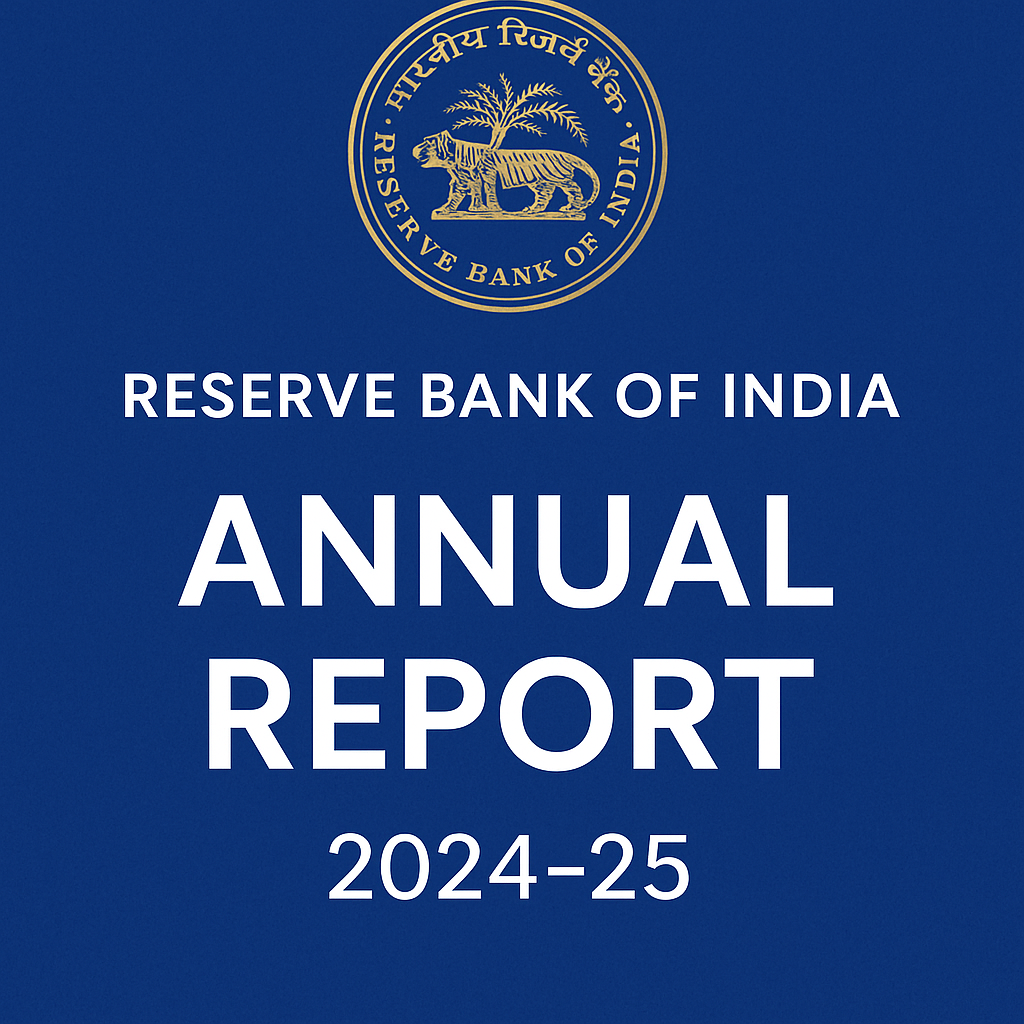The Reserve Bank of India (RBI) released its Annual Report 2024-25, offering a comprehensive review of India’s economic performance, monetary policy, and regulatory initiatives. This year’s report underlines India’s economic resilience amidst global uncertainty and presents a cautiously optimistic outlook for 2025-26.
In this article, we break down the key highlights of the RBI Annual Report 2024-25, decode what they mean for India’s economy, and explore future prospects.
India’s Economic Performance in 2024-25
According to the RBI Annual Report 2024-25, India retained its position as the fastest-growing major economy with a GDP growth rate of 6.5%, despite global headwinds. Key drivers included:
- Robust service sector performance with 7.5% growth.
- Record foodgrain production boosting the agriculture sector’s GVA to 4.6%.
- Continued emphasis on public capital expenditure.
- Stable macroeconomic indicators like low current account deficit (CAD) and strong forex reserves.
These achievements align with the RBI’s core mandate of maintaining financial stability while supporting inclusive economic growth.
Inflation and Monetary Policy: Easing the Pressure
The report noted a significant decline in inflation, with headline CPI inflation moderating to an average of 4.6% from 5.4% a year ago. Key factors contributing to the drop:
- Cooling input costs.
- Supply-side measures by the government.
- Lower global fuel prices.
Despite intermittent spikes in food inflation, particularly in vegetables and cereals, the Monetary Policy Committee (MPC) managed to stay the course, eventually reducing the repo rate to 6.25% in February 2025, reflecting confidence in the disinflation process.
Financial Sector: Stable and Resilient
The banking sector continued to demonstrate robust health:
- Double-digit credit growth.
- Improved asset quality, with declining Gross and Net NPA ratios.
- Strong profitability indicators (RoA, RoE) and high capital adequacy.
NBFCs and Urban Cooperative Banks (UCBs) also showed positive momentum, supported by regulatory changes and easing of risk weights to promote credit flow.
The RBI Annual Report 2024-25 also outlines enhanced supervisory measures, including AI/ML-enabled risk analytics and a dedicated supervisory data quality index (sDQI), reinforcing the safety of the financial ecosystem.
Currency and Payment Systems: Driving Digital Innovation
India maintained momentum in digital payments, recording a 34.8% increase in volume and becoming the global leader in real-time transactions, thanks to the Unified Payments Interface (UPI). Major developments included:
- Introduction of “Delegated Payments” for shared UPI access.
- Expansion of CBDC-Retail (Digital Rupee) pilot to 60 lakh users.
- Project Nexus linking India’s fast payment systems with ASEAN nations.
These initiatives reflect the RBI’s push to make financial services inclusive, accessible, and secure.
Forex, External Sector & Global Trade
The external sector posed challenges:
- Marginal rise in merchandise exports (0.1%).
- Increase in imports led to a wider trade deficit of $282.8 billion.
- Capital flows were volatile, with subdued FDI and FPI in the latter half.
However, forex reserves remained solid at $668.3 billion, covering over 11 months of imports. Services exports and remittances also helped cushion the current account deficit, keeping it manageable at 1.3% of GDP.
Policy and Regulatory Innovations
The RBI introduced several forward-looking measures in 2024-25:
- Launch of FinTech and EmTech Repositories to monitor technological innovation.
- Regulatory sandbox expansions and new guidelines for AI/ML adoption in finance.
- Initiatives like the Green Hydrogen Mission, E-Drive Scheme, and sovereign green bonds to promote climate-resilient finance.
Looking Ahead: Economic Prospects for 2025-26
The RBI projects that India will continue to lead global growth in 2025-26, driven by:
- Rising private consumption and investment.
- Likely above-normal monsoon aiding agriculture.
- Continued emphasis on capital expenditure and digital infrastructure.
Potential risks include geopolitical uncertainties, global financial market volatility, and protectionist trade policies, but India’s fundamentals remain strong.
Final Thoughts
The RBI Annual Report 2024-25 not only showcases a strong economic performance amid global headwinds but also sets the tone for a sustainable, tech-enabled, and inclusive future. With strategic policy shifts and innovations, the RBI continues to anchor stability while embracing transformation.
For students, researchers, and aspirants preparing for banking exams like RBI Grade B, SBI PO, or IBPS PO, this report is a treasure trove of current economic affairs, financial policy insights, and data-driven trends.
Frequently Asked Questions (FAQs) About the RBI Report
Q1: What is the GDP growth rate of India according to the RBI Annual Report 2024-25?
A: As per the RBI Annual Report 2024-25, India’s GDP growth for the year was 6.5%, making it the fastest-growing major economy.
Q2: What are the key highlights of the RBI Annual Report 2024-25?
A: Key highlights include moderation in inflation to 4.6%, robust digital payment growth, resilient banking sector performance, expansion of the digital rupee, and a positive outlook for 2025-26.
Q3: What is RBI’s projection for India’s economy in 2025-26?
A: The RBI projects continued strong growth in 2025-26, supported by rising private consumption, stable macroeconomic fundamentals, and a strong push on public investment.
Q4: What developments were made in digital payments according to the RBI Annual Report 2024-25?
A: Digital payments grew by 34.8% in volume, with the UPI leading the way. The RBI also expanded the Central Bank Digital Currency (CBDC) and introduced “Delegated Payments” to boost inclusion.

Great info sir 👍